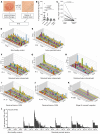Clinically resolved psoriatic lesions contain psoriasis-specific IL-17-producing αβ T cell clones
- PMID: 28945199
- PMCID: PMC5663366
- DOI: 10.1172/JCI93396
Clinically resolved psoriatic lesions contain psoriasis-specific IL-17-producing αβ T cell clones
Abstract
In psoriasis, an IL-17-mediated inflammatory skin disease, skin lesions resolve with therapy, but often recur in the same locations when therapy is discontinued. We propose that residual T cell populations in resolved psoriatic lesions represent the pathogenic T cells of origin in this disease. Utilizing high-throughput screening (HTS) of the T cell receptor (TCR) and immunostaining, we found that clinically resolved psoriatic lesions contained oligoclonal populations of T cells that produced IL-17A in both resolved and active psoriatic lesions. Putative pathogenic clones preferentially utilized particular Vβ and Vα subfamilies. We identified 15 TCRβ and 4 TCRα antigen receptor sequences shared between psoriasis patients and not observed in healthy controls or other inflammatory skin conditions. To address the relative roles of αβ versus γδ T cells in psoriasis, we carried out TCR/δ HTS. These studies demonstrated that the majority of T cells in psoriasis and healthy skin are αβ T cells. γδ T cells made up 1% of T cells in active psoriasis, less than 1% in resolved psoriatic lesions, and less than 2% in healthy skin. All of the 70 most frequent putative pathogenic T cell clones were αβ T cells. In summary, IL-17-producing αβ T cell clones with psoriasis-specific antigen receptors exist in clinically resolved psoriatic skin lesions. These cells likely represent the disease-initiating pathogenic T cells in psoriasis, suggesting that lasting control of this disease will require suppression of these resident T cell populations.
Conflict of interest statement
Figures






Similar articles
-
Potential role of IL-17-producing CD4/CD8 double negative αβ T cells in psoriatic skin inflammation in a TPA-induced STAT3C transgenic mouse model.J Dermatol Sci. 2017 Jan;85(1):27-35. doi: 10.1016/j.jdermsci.2016.10.007. Epub 2016 Oct 19. J Dermatol Sci. 2017. PMID: 27810232
-
Etanercept downregulates the Th17 pathway and decreases the IL-17+/IL-10+ cell ratio in patients with psoriasis vulgaris.J Clin Immunol. 2012 Dec;32(6):1221-32. doi: 10.1007/s10875-012-9716-x. Epub 2012 Jun 15. J Clin Immunol. 2012. PMID: 22699761
-
VEGF-A promotes IL-17A-producing γδ T cell accumulation in mouse skin and serves as a chemotactic factor for plasmacytoid dendritic cells.J Dermatol Sci. 2014 May;74(2):116-24. doi: 10.1016/j.jdermsci.2013.12.013. Epub 2014 Jan 13. J Dermatol Sci. 2014. PMID: 24485663
-
Interleukin-17-producing γδ T (γδ17) cells in inflammatory diseases.Immunology. 2018 Dec;155(4):418-426. doi: 10.1111/imm.12993. Epub 2018 Sep 10. Immunology. 2018. PMID: 30133701 Free PMC article. Review.
-
T cell responses in psoriasis and psoriatic arthritis.Autoimmun Rev. 2015 Apr;14(4):286-92. doi: 10.1016/j.autrev.2014.11.012. Epub 2014 Nov 28. Autoimmun Rev. 2015. PMID: 25445403 Review.
Cited by
-
Local IL-23 is required for proliferation and retention of skin-resident memory TH17 cells.Sci Immunol. 2022 Nov 18;7(77):eabq3254. doi: 10.1126/sciimmunol.abq3254. Epub 2022 Nov 11. Sci Immunol. 2022. PMID: 36367947 Free PMC article.
-
Tissue-resident memory T cells and their biological characteristics in the recurrence of inflammatory skin disorders.Cell Mol Immunol. 2020 Jan;17(1):64-75. doi: 10.1038/s41423-019-0291-4. Epub 2019 Oct 8. Cell Mol Immunol. 2020. PMID: 31595056 Free PMC article. Review.
-
Defect of IL17 Signaling, but Not Centrinone, Inhibits the Development of Psoriasis and Skin Papilloma in Mouse Models.Biomedicines. 2022 Aug 15;10(8):1976. doi: 10.3390/biomedicines10081976. Biomedicines. 2022. PMID: 36009523 Free PMC article.
-
Group A Streptococcus induces CD1a-autoreactive T cells and promotes psoriatic inflammation.Sci Immunol. 2023 Jun 8;8(84):eadd9232. doi: 10.1126/sciimmunol.add9232. Epub 2023 Jun 2. Sci Immunol. 2023. PMID: 37267382 Free PMC article.
-
Mouse Models of Psoriasis: A Comprehensive Review.J Invest Dermatol. 2022 Mar;142(3 Pt B):884-897. doi: 10.1016/j.jid.2021.06.019. Epub 2021 Dec 23. J Invest Dermatol. 2022. PMID: 34953514 Free PMC article. Review.
References
MeSH terms
Substances
Grants and funding
LinkOut - more resources
Full Text Sources
Other Literature Sources
Medical

